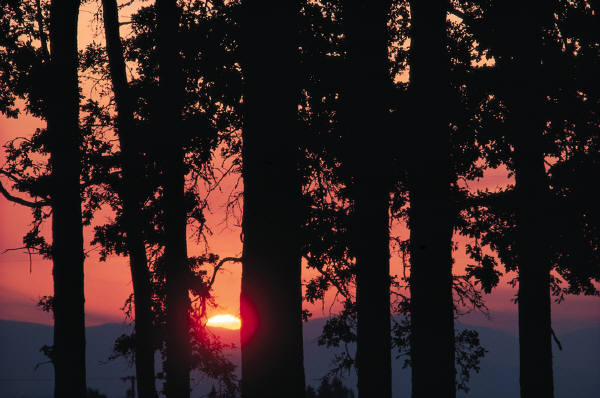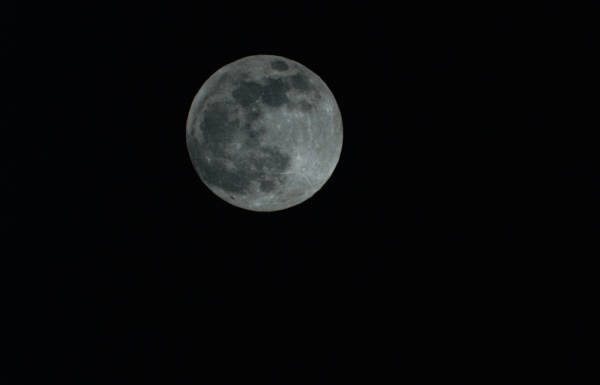Night Watch
It was dark--really dark.. OK, it was not cave dark; if one
waited a bit, one could soon make out trees, water and sky, and see where
they met. But for this 12-year-old city-girl looking around under a
cloudy, starless sky, it was as dark as any dark I had ever seen.
We were camping in Canada, well north of most cities and towns, far from
the light pollution which plagues the eastern megalopolis where I had lived
all my life. To me, it was dark.
The night had come on slowly. The sun set over the lake as we
settle by our first camp fire of the trip. We had canoed all day, and pulled into our campsite just in time to see the bats
come out. At first, I thought they were butterflies , but there were
millions of them. And I mean millions. The air turned black
with bats swirling our of some hidden cave on the island in the lake where
we camped. Then they scattered and were gone, each bat searching for
its own food.
canoed all day, and pulled into our campsite just in time to see the bats
come out. At first, I thought they were butterflies , but there were
millions of them. And I mean millions. The air turned black
with bats swirling our of some hidden cave on the island in the lake where
we camped. Then they scattered and were gone, each bat searching for
its own food.
We kids soon settled into our sleeping bags. After a long day of
setting up camp and exploring, one might think that we would fall asleep
and stay asleep, but this was not so. It was noisy in the woods!
there were animal calls--frogs and flying squirrels, and insects--and odd
scratching sounds that were very close. Early in the morning, we
awoke to find all our food scattered in a trail heading up the hill, and
most of it eaten. Whatever it was, it preferred chocolate and
relished Oreos. It was clearly the work of a bear. Black bears
were very common in these parts, and, as we saw later, they were no
stranger to picnic baskets and campsites.
From the evidence, we quickly put together a view of that evening from
the bears' (we thought there might be more than one, and we were correct)
perspective. Our canoes, laden with food, were moored a short
swim away. It was a short swim for the bears, too. They grabbed
the food bags and headed for shore, and once there, tore the bags open and
ate what they liked best as they frolicked up the steep hill behind the
campsite. My mother was especially saddened by the empty "Special
Dark" chocolate bar wrapper, torn and left empty along the trail of food
leavings. After a bit of discussion with the rangers, we found ways
of preventing the bears from continuing their nightly raids, and we could
begin to enjoy the late nights, and the other wild things that haunt the
darkness.
In her terrific book
Discover Nature At Sundown Dark Elizabeth Lawlor describes the evening
and night: "We are strangers in this noisy world that is pungent with
the spicy-sweet fragrance of night-blooming flowers. It is a magical
world that offers us an opportunity to sharpen our senses. The night
is a time to explore, not to fear." I agree!
When I was teaching, one of my favorite settings was the night hike.
A class would stay overnight in a state park, or a school would have an
evening program in midwinter, and I would prepare some activities and
readings for the class which would help to familiarize them with the night.
Many had never been outside for long in the darkness, and were frightened.
Some giggled nervously at the thought of being outside in a wild place;
some were amazed by the look of the tame school-yard made strange by the
shadows of the night. By the end of the evening, most were thrilled
by the experience, whether they had mastered their fears with solo hikes
(older kids), or merely had fun with evening sensory activities (everyone).
These night hikes can be done in single families or in small groups.
Finding a place to do a high school night hike is the biggest challenge,
but most of us can do an evening hike, even in a city park, with permission
of the rangers...and, if necessary, by hiring a naturalist for the evening. I was amused to find that the
evening program in a state park in Massachusetts was nearly identical to
the program I did in a state park in NY (and my kids enjoyed getting all
the answers right!!). since many of these activities are easily done
in the typical back yard, we can start with these simple plans and
materials. I do list books for night time ideas and information after
the activities, but I decided to concentrate on activities this time.
Questions? Feedback? E-mail
me!
by hiring a naturalist for the evening. I was amused to find that the
evening program in a state park in Massachusetts was nearly identical to
the program I did in a state park in NY (and my kids enjoyed getting all
the answers right!!). since many of these activities are easily done
in the typical back yard, we can start with these simple plans and
materials. I do list books for night time ideas and information after
the activities, but I decided to concentrate on activities this time.
Questions? Feedback? E-mail
me!
The nighttime activity pack (pack it in secret, so you don't give any
clues away!!):
- pencils (one per person)
- colored construction paper squares, about 2"x2", with several
colors represented
- paper lunch bags, each with a texture in it (cotton balls, rice,
sandpaper, etc.)
- one small rock per person (in a rocky area, each person might find
his own)
- Oyster crackers (one box)
- wintergreen Lifesavers (not the sugar free kind)
- One large paper bag (grocery)
- Small zipper-bags with a scent (sage, vanilla, cinnamon, lemon,
rose, etc.)
- flashlight, to be used only in emergencies
Activities for younger kids:
1. Taste test (before you go out)
Let everyone have one oyster cracker. Tell them to remember
how it tastes. Later, at the end of the next activity, let
everyone try another oyster cracker. Does it taste different?
(sometimes we feel that things have a stronger taste if we cannot see
as well)
2. Let your eyes adjust to the darkness when you head outside
(this might take a few minutes).
3. Fox Ears
Make two lines across, with each person facing a partner. One
partner will be moving and he will carefully back away from the
stationary partner, while one (stationary) partner is whispering the
name of the other partner. When one can no longer hear his
partner, he stops. He then cups his hands around his ears to make
his outer ear bigger, and listens for the voice of his partner.
Can he hear now? Switch roles, and try again.
4. What Color?
Give each person a square of construction paper (this is best done
in the darkest place) and a pencil. Ask each person to write the
color he thinks the paper is on the paper. Collect the papers to
examine inside when the hike is over.
5. My Pet Rock (best with a large group)
Give each person a rock, or have each find one on the ground.
Sit in a circle. Tell each person to hold his rock and get to
know its features. then, when you tell everyone to begin, each
will pass his rock to the person to his left. The group will keep
passing rocks until each believes he has his own rock back. Is it
easy or difficult? Is everyone sure he has his own back?
6. Sparks in the Dark
While you are all sitting in a group, bring out the lifesavers.
Have each person eat his, chewing with his mouth open, and see what
happens when the sugar molecules are broken with wintergreen oil to
catch the energy released. This is really just for fun, but it
must be done in the dark.
7. Sensory bags
Have each person feel inside a bag, or smell a scent, and determine
what each is. Discuss how animals get clues about their
surroundings when light is scarce.
8. Bat and Moth
This is a fun group game based on echo-location in bats. Have
everyone stand in a circle. Put a paper bag (big) over the head
of the "bat" (as a blindfold) and chose a "moth" from the other people.
The bat and moth must stay within the circle of people. The bat
can only say "beep" and the moth must only echo back "boop".
Based on the "boop" the bat must try to locate the moth (his dinner).
Older kids:
9. Solo Walk
This can only be done in a safe place, so if there are any doubts,
try the next activity. On a straight path, one adult will walk 60
seconds away into the dark down the trail. An adult at the other
end will send each participant down the trail until he meets up with
the next person. All must remain silent until this activity is
over, as listening is the point.
10. Solo Sit
Each person sits away from the other participants, within sight, but
all must remain silent and listen for 60 seconds. Discussion of
what participants hear, or a writing assignment may follow.
Books for night studies:
Older kids and parents--
Picture books--
Great reading for night time adventure
Discover Nature At Sundown
A Guide to Night Sounds
Forest Bright, Forest Night
Nights of the Pufflings (a true story!)
Owl Moon
Fireflies
Wait Till the Moon is Full
Night in the Country
Hello, Harvest Moon
Bat Loves the Night
Copyright 2005. Please
e-mail for permission to republish.
Return to Wild Monthly
 canoed all day, and pulled into our campsite just in time to see the bats
come out. At first, I thought they were butterflies , but there were
millions of them. And I mean millions. The air turned black
with bats swirling our of some hidden cave on the island in the lake where
we camped. Then they scattered and were gone, each bat searching for
its own food.
canoed all day, and pulled into our campsite just in time to see the bats
come out. At first, I thought they were butterflies , but there were
millions of them. And I mean millions. The air turned black
with bats swirling our of some hidden cave on the island in the lake where
we camped. Then they scattered and were gone, each bat searching for
its own food. by hiring a naturalist for the evening. I was amused to find that the
evening program in a state park in Massachusetts was nearly identical to
the program I did in a state park in NY (and my kids enjoyed getting all
the answers right!!). since many of these activities are easily done
in the typical back yard, we can start with these simple plans and
materials. I do list books for night time ideas and information after
the activities, but I decided to concentrate on activities this time.
Questions? Feedback?
by hiring a naturalist for the evening. I was amused to find that the
evening program in a state park in Massachusetts was nearly identical to
the program I did in a state park in NY (and my kids enjoyed getting all
the answers right!!). since many of these activities are easily done
in the typical back yard, we can start with these simple plans and
materials. I do list books for night time ideas and information after
the activities, but I decided to concentrate on activities this time.
Questions? Feedback?